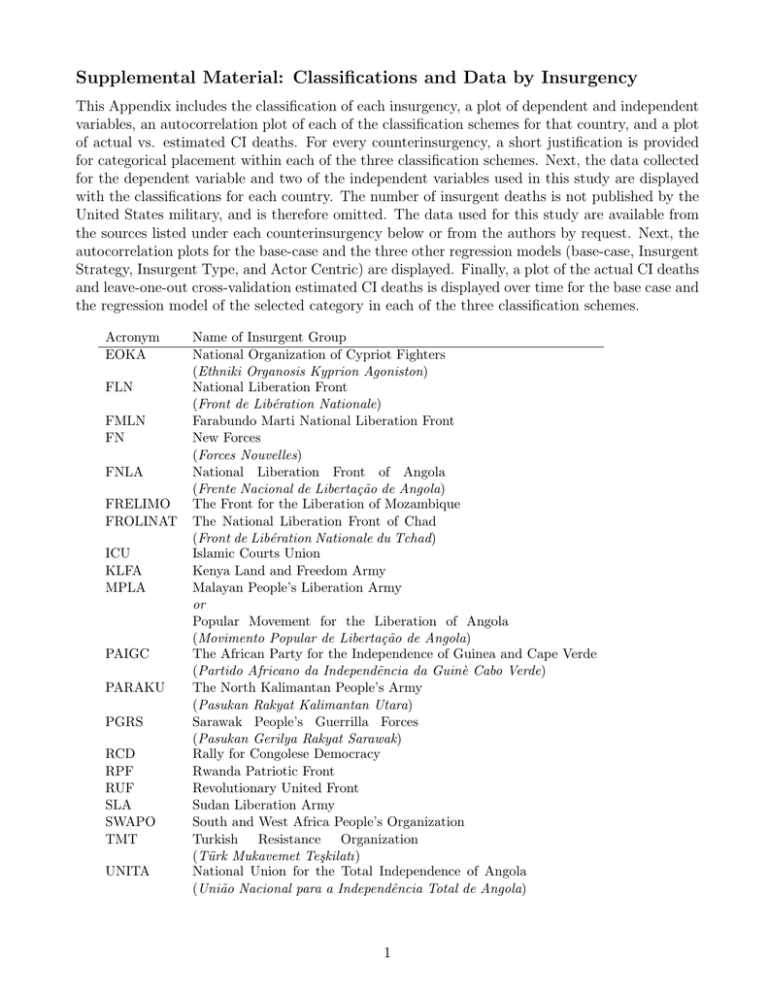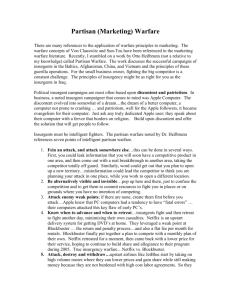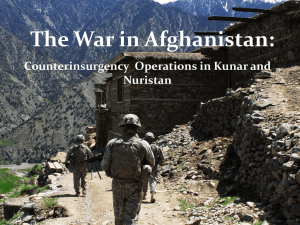Supplemental Material: Classifications and Data by Insurgency
advertisement

Supplemental Material: Classifications and Data by Insurgency This Appendix includes the classification of each insurgency, a plot of dependent and independent variables, an autocorrelation plot of each of the classification schemes for that country, and a plot of actual vs. estimated CI deaths. For every counterinsurgency, a short justification is provided for categorical placement within each of the three classification schemes. Next, the data collected for the dependent variable and two of the independent variables used in this study are displayed with the classifications for each country. The number of insurgent deaths is not published by the United States military, and is therefore omitted. The data used for this study are available from the sources listed under each counterinsurgency below or from the authors by request. Next, the autocorrelation plots for the base-case and the three other regression models (base-case, Insurgent Strategy, Insurgent Type, and Actor Centric) are displayed. Finally, a plot of the actual CI deaths and leave-one-out cross-validation estimated CI deaths is displayed over time for the base case and the regression model of the selected category in each of the three classification schemes. Acronym EOKA FLN FMLN FN FNLA FRELIMO FROLINAT ICU KLFA MPLA PAIGC PARAKU PGRS RCD RPF RUF SLA SWAPO TMT UNITA Name of Insurgent Group National Organization of Cypriot Fighters (Ethniki Organosis Kyprion Agoniston) National Liberation Front (Front de Libération Nationale) Farabundo Marti National Liberation Front New Forces (Forces Nouvelles) National Liberation Front of Angola (Frente Nacional de Libertação de Angola) The Front for the Liberation of Mozambique The National Liberation Front of Chad (Front de Libération Nationale du Tchad) Islamic Courts Union Kenya Land and Freedom Army Malayan People’s Liberation Army or Popular Movement for the Liberation of Angola (Movimento Popular de Libertação de Angola) The African Party for the Independence of Guinea and Cape Verde (Partido Africano da Independẽncia da Guinè Cabo Verde) The North Kalimantan People’s Army (Pasukan Rakyat Kalimantan Utara) Sarawak People’s Guerrilla Forces (Pasukan Gerilya Rakyat Sarawak) Rally for Congolese Democracy Rwanda Patriotic Front Revolutionary United Front Sudan Liberation Army South and West Africa People’s Organization Turkish Resistance Organization (Türk Mukavemet Teşkilatı) National Union for the Total Independence of Angola (União Nacional para a Independência Total de Angola) 1 Afghanistan Scheme Insurgent Strategy 1980-1989 Category Mil-focused Insurgent Type Traditionalist Insurgents either supported the former government, an Islamic form of government, or a combination of the two. Actor Centric Domestic Regime Change Insurgents either supported the former government, an Islamic form of government, or a combination of the two. Justification Military action was the primary means of power struggle, land was a major measure of control, and political considerations came after fighting decided the winner. Sources: CAA (2009), Clodfelter (2007), Heston et al. (2011) 2 3 Afghanistan Scheme Insurgent Strategy 2001-2010 Category Urban war Justification There was prevalent use of roadside bombs and suicide attacks. Insurgent Type Traditionalist Insurgents desired a traditional form of government. Actor Centric International Regime Change US forces implemented a new government at the beginning of the war. Sources: CAA (2009), Livingston and O’Hanlon (2012), Heston et al. (2011), Marston (2008) 4 5 Algeria Scheme Insurgent Strategy 1954-1962 Category PPW Insurgent Type Egalitarian The FLN was socialist-nationalist, although it was a composite umbrella group. There was one-party rule after the revolution. Actor Centric Colonial Policing Action Algeria was a colony of France. Justification The FLN (National Liberation Front) had a dominant political arm. Sources: CAA (2009), Clodfelter (2007), Heston et al. (2011) 6 7 Angola Scheme Insurgent Strategy 1962-1970 Category Mil-Focus Insurgent Type Egalitarian The UNITA and MPLA had a socialist-communist philosophy. Actor Centric Domestic Regime Change This was an internal domestic regime change. The Portuguese granted Angola independence, but with only a provisional government remaining. Justification Three groups held territory in the conflict with military units (UNITA, FNLA, MPLA). The success of insurgents was measured by holding land with military force. UNITA-National Union for the Total Independence of Angola Sources: CAA (2009), Clodfelter (2007), Janes (1999), Heston et al. (2011) 8 9 Angola Scheme Insurgent Strategy 1975-1985 Category Mil-Focus Insurgent Type Egalitarian UNITA aligned with the Communist Block, shifting to Democratic (Pluralist) only when it suited their needs to take power. Actor Centric Domestic Regime Change UNITA fought the government forces for control of the government. Justification UNITA fought with conventional and guerrilla tactics against the government. Sources: CAA (2009), Clodfelter (2007), Janes (1999), Heston et al. (2011) 10 11 Angola Scheme Insurgent Strategy 1992-1999 Category Mil-Focused Insurgent Type Comercialist Savimbi (the UNITA leader) used profit from diamonds to further his personal ambitions. UNITA disbanded after Savimbi’s death, indicating that the goals of the group were linked to the personal ambitions of Savimbi, rather than the members of the group. Actor Centric Domestic Regime Change This was an internal struggle for leadership of the country. Justification UNITA used conventional and guerrilla tactics. Sources: CAA (2009), Clodfelter (2007), Heston et al. (2011), Snow (1997) 12 13 Borneo Scheme Insurgent Strategy 1963-1966 Category Mil-Focus Insurgent Type Secessionist PARAKU and PGRS attempted independence from Malaya and UK (as set up by the British). Actor Centric Colonial Policing Action Malaya was in transition from a British colony. Justification Both sides relied on military force (and support from the British and Indonesia). Sources: CAA (2009), Clodfelter (2007), Heston et al. (2011) 14 15 Bosnia Scheme Insurgent Strategy 1992-1994 Category Mil-Focus Justification Both the Serbians and Bosnians used military units. Insurgent Type Seccessionist Bosnia desired independence from Serbia. Actor Centric Separatist Bosnia desired independence from Serbia. Sources: CAA (2009), Clodfelter (2007), Paul, Clark and Grill (2010), Heston et al. (2011) 16 17 Burundi Scheme Insurgent Strategy 2004-5 Category Mil-Focused Justification The armed wing of the FLN conducted military and guerrilla attacks. Insurgent Type Reformist The FLN settled with the Burundi government to end the insurgency in 2006. Actor Centric Domestic Regime Change The FLN settled with the Burundi government to end the insurgency in 2006. Sources: CAA (2009), Janes (1999), Paul, Clark and Grill (2010), Heston et al. (2011) 18 19 Chad Scheme Insurgent Strategy 1969-1971 Category Mil-Focus Insurgent Type Reformist FROLINAT desired greater representation, not independence. Actor Centric Domestic Resistance The French redeployed after government concessions. Justification The conflict revolved around land control by military force. Political actions were suppressed by the government. Sources: CAA (2009), Clodfelter (2007), Heston et al. (2011) 20 21 Chad Scheme Insurgent Strategy Insurgent Type 1980-81 Category Mil-Focus Commercialist The conflict was personality driven, and FROLINAT was split among allegiances, not ideology. Actor Centric Domestic Regime Change Factional leaders vied for power to lead the government. Justification Each of the factions controlled territory. Sources: CAA (2009), Clodfelter (2007), Heston et al. (2011) 22 23 Chechnya Scheme Insurgent Strategy 1999-2007 Category Urban war Insurgent Type Secessionist Chechnya desired independence from Russia. Actor Centric Separatist Chechnya desired independence from Russia. Justification Insurgents conducted guerrilla tactics as well as conventional fighting in urban areas. Sources: CAA (2009), Clodfelter (2007), Heston et al. (2011) 24 25 Congo Insurgent Strategy Strategy 1961-1963 Category Justification Mil-Focused The Kantangan forces held land. Insurgent Type Secessionist The Kantangan and Kasai provinces declared independence. Actor Centric Separatists The Kantangan and Kasai provinces declared independence. Sources: CAA (2009), Clodfelter (2007), Heston et al. (2011) 26 27 Congo Scheme Insurgent Strategy 2001-2006 Category Mil-Focused Justification RCD, Ugandan and Rwandan-backed forces fought with military units. Insurgent Type Reformist Insurgents desired a governement that did not oppress Tutsis. Actor Centric Domestic Regime Change Insurgents desired a government that did not oppress Tutsis. Sources: CAA (2009), Clodfelter (2007), Paul, Clark and Grill (2010), Heston et al. (2011) 28 29 Croatia Scheme Insurgent Strategy 1992-1995 Category Mil-Focus Justification All sides had military units fighting. Insurgent Type Secessionist Serbians attempted independence from part of Croatia. Actor Centric Separatist Serbians attempted independence from part of Croatia. Sources: CAA (2009), Clodfelter (2007), Paul, Clark and Grill (2010), Heston et al. (2011) 30 31 Cyprus Scheme Insurgent Strategy 1955-1958 Category Urban War Insurgent Type Secessionist EOKA desired union with Greece and TMT desired partition. Actor Centric Separatist EOKA desired union with Greece and TMT desired partition. Justification Insurgents conducted a campaign of protests, sabotage, and assassinations without intent to claim territory. Sources: CAA (2009), Clodfelter (2007), Heston et al. (2011) 32 33 Darfur (Sudan) Scheme Insurgent Strategy 2005-2008 Category Mil-Focus Justification Conventional fighting for control of territory. Insurgent Type Secessionist SLA was a liberation movement. Actor Centric Separatist SLA was a liberation movement. Sources: CAA (2009), Clodfelter (2007), Heston et al. (2011) 34 35 El Salvador Scheme Insurgent Strategy 1983-1987 Category PPW Justification The FMLN was identified as a protracted popular war by O’Neill. Insurgent Type Egalitarian The FMLN was identified as Egalitarian by O’Neill. Actor Centric Domestic Resistance The FMLN settled for amnesty and reorganization of government paramilitary forces. Sources: CAA (2009), Clodfelter (2007), Paul, Clark and Grill (2010), Heston et al. (2011) 36 37 Iraq Scheme Insurgent Strategy 2003-2008 Category Urban War Insurgent Type Traditionalist Multiple groups, but generally have a vision of an Islamic state. Actor Centric International Regime Change US and Coalition forced entry and removed regime. Justification Campaign of roadside bombs, guerrilla tactics. Control of land was a secondary consideration. Sources: Biddle, Friedman, and Shapiro (2012), CAA (2009), Clodfelter (2007), O’Hanlon and Livingston (2012), Heston et al. (2011) 38 39 Ivory Coast Scheme Insurgent Strategy 2003-2005 Category Mil-Focus Justification Conventional military units and defined land boundaries. Insurgent Type Reformist FN had no demands or displayed actions of separation. Actor Centric Domestic Resistance FN had no demands or displayed actions of separation. Sources: CAA (2009), Heston et al. (2011) 40 41 Katanga Scheme Insurgent Strategy 1961-1963 Category Mil-Focus Justification Kantangan forces holding land was the major measure of success. Insurgent Type Secessionist Belgium supported insurgents attempting to separate from Congo (Katanga). Actor Centric Separatist Belgium supported insurgents attempting to separate from Congo (Katanga). Sources: CAA (2009), Clodfelter (2007), Heston et al. (2011) 42 43 Kenya Scheme Insurgent Strategy 1952-1956 Category Mil-Focus Justification The Mau Mau (KLFA) organized into military units. Insurgent Type Secessionist The Mau Mau desired independence from Britain. Actor Centric Colonial Policing Action Kenya did not gain independence until 1963. Sources: CAA (2009), Heston et al. (2011) 44 45 Lebanon Scheme Insurgent Strategy 1991-1999 Category Urban War Justification Hizbollah conducted guerrilla tactics in an urban environment. Insurgent Type Traditionalist At this time, Hizbollah desired a traditional Shia government. Actor Centric Domestic Regime Change At this time, Hizbollah desired a traditional Shia government. Sources: CAA (2009), Defronzo (2011), Janes (1999), Heston et al. (2011) 46 47 Lebanon Scheme Insurgent Strategy 2006 Category Urban War Insurgent Type Reformist Hezbollah desired more control in the Lebanese government. Actor Centric Domestic Resistance Hezbollah desired more control in the Lebanese government. Justification The insurgent campaign consisted of rockets and kidnapping, among other tactics. Sources: CAA (2009), Heston et al. (2011) 48 49 Malaya Scheme Insurgent Strategy 1955-1960 Category Protracted Popular War Insurgent Type Egalitarian MPLA possessed a communist ideology. Actor Centric Colonial Policing Action Malaya was a British colony at the time. Justification Political and military components were present. Sources: CAA (2009), Clodfelter (2007), Heston et al. (2011), Stubbs (2008) 50 51 Mozambique Scheme Insurgent Strategy 1967-1974 Category Protracted Popular War Insurgent Type Secessionist FRELIMO espoused a Marxist philosophy during the insurgency and a singleparty Marxist state after. Actor Centric Colonial Policing Action Colony of Portugal until the Carnation Revolution. Justification Both political and military action. Sources: CAA (2009), Heston et al. (2011) 52 53 Namibia Scheme Insurgent Strategy 1971-1989 Category Mil-Focus Justification Conventional and guerrilla tactics were used by insurgents. Insurgent Type Secessionist Identified as Secessionist by O’Neill. Actor Centric Separatist SWAPO resisted governance of South Africa. Sources: CAA (2009), Heston et al. (2011) 54 55 North Ireland Scheme Insurgent Strategy 1970-1997 Category Urban War Justification Nationalists used guerrilla tactics in an urban environment. Insurgent Type Secessionist Nationalists desired independence from Britain. Actor Centric Separatist Nationalists desired independence from Britain. Sources: CAA (2009), Clodfelter (2007), Iron (2008), Heston et al. (2011) 56 57 Portuguese Guinea Scheme Insurgent Strategy 1969-1973 Category Mil-Focused Insurgent Type Secessionist The PAIGC desired an independent state. Actor Centric Colonial Policing Action Guinea was a Portuguese colony at the time. Justification There was no political movement accompanying the use of forces. The PAIGC controlled territory Sources: CAA (2009), Clodfelter (2007), Heston et al. (2011) 58 59 Rwanda Scheme Insurgent Strategy 1994-1995 Category Mil-Focused Insurgent Type Traditionalist The Tutsi believed the only way to prevent unfair rule by the Hutu was to control the government. Actor Centric Domestic Regime Change The Tutsi desired a new Tutsi-led government. Justification The RPF held territory. Sources: CAA (2009), Paul, Clark and Grill (2010), Heston et al. (2011), Marston (2008), Snow (1997) 60 61 Sierra Leone Scheme Insurgent Strategy 1997-2001 Category Mil-Focused Insurgent Type Commercialist RUF lacked a cohesive pervasive ideology and committed extreme human rights violations. Actor Centric Domestic Regime Change The insurgency successfully (temporarily) changed the ruling party. Justification The government and RUF based control on military force. Sources: CAA (2009), Heston et al. (2011) 62 63 Somalia Scheme Insurgent Strategy 1993-1995 Category Mil-Focused Justification The factions fought between each other with military units. Insurgent Type Commercialist Multiple factions signed ceasefires that were not kept. Actor Centric Domestic Resistance Each faction desired power in the governing structure. Sources: CAA (2009), Clodfelter (2007), Heston et al. (2011) 64 65 Somalia Scheme Insurgent Strategy 2006-2008 Category Urban War Justification Urban fighting, traditional fighting units and guerrilla tactics. Insurgent Type Traditionalist Insurgents joined Al-Shabaab or Hizbul Islam after the negotiated settlement. Actor Centric International Regime Change Ethiopian forces, supported by the US, and regional forces overthrew the ICU. Sources: CAA (2009), Heston et al. (2011) 66 67 Tibet Scheme Insurgent Strategy 1956,59,61 Category Mil-Focused Justification Tibetans organized themselves into military units. Insurgent Type Secessionist Tibet desired independence from China. Actor Centric Separatists Tibet desired independence from China. Sources: CAA (2009), Clodfelter (2007), Janes (1999), Heston et al. (2011) 68 69 Supplemental Material: Regression Analysis The following tables describe the attributes of the regression models, to include the Box-Cox power (Power) and the regression coefficients (Reg. Coef.), the standardized coefficients (Std. Coef.), the p-value of the constants and 2 independent variables (p-value), the adjusted R-squared (Radj ), the p-value of the Shapiro-Wilk test (S-W), and the number of observations (n) and countries in each category. Table 1: Insurgent Strategy Classification Scheme Multiple Linear Regression Results Category/Variables Protracted Popular War 2 Radj = 0.930 n=18, Countries: 4 CD Intercept CF ID GDP Military Focus 2 Radj = 0.556 n=95, Countries: 23 CD Intercept CF ID GDP Urban Warfare 2 Radj = 0.849 n=64, Countries: 7 CD Intercept CF ID GDP Power Reg. Coef. Std. Coef. p-value 2.77 0.068 0.424 -0.531 2.065 1.342 -1.25 0.012 <0.001 <0.001 <0.001 -14.435 2.078 0.304 – 1.35 0.842 – <0.001 <0.001 <0.001 – 1.186 2.379 0.548 <0.001 <0.001 <0.001 0.018 S-W:0.49 0.09 0.26 0.10 0.12 S-W:0.43 0.01 -0.05 0.06 -0.14 S-W:0.85 0.12 -0.10 -0.06 0.74 70 -19.764 3.065 1.159 0.001 Table 2: Insurgent Type Classification Scheme Multiple Linear Regression Results Category/Variables Egalitarian 2 Radj = 0.736 n=17, Countries: 4 CD Intercept CF ID GDP Traditionalist 2 =0.876 Radj n=40, Countries: 6 CD Intercept CF ID GDP Secessionist 2 Radj = 0.661 n=90, Countries: 15 CD Intercept CF ID GDP Reformist 2 Radj = 0.277 n=14, Countries: 5 CD Intercept CF ID GDP Commericalist 2 Radj = 0.718 n=16, Countries: 4 CD Intercept CF ID GDP Power Coef. Reg. Coef. Std. Coef. p-value S-W:0.86 -0.12 0.09 0.24 2.28 -6.692 0.518 – 0 2.389 – 1.305 0.005 <0.001 – 0.014 12.112 0.418 0.26 -6.057 3.04 0.91 -1.198 0.064 <0.001 0.049 0.005 -32.759 7.643 0.915 0.074 0.966 1.442 0.349 <0.001 <0.001 <0.001 0.052 0.879 – 1.313 0.026 0.142 – 0.038 1.45 1.156 – <0.001 <0.001 <0.001 – S-W:0.35 0.13 0.19 0.05 -0.22 S-W:0.92 0.056 -0.21 -0.09 0.14 S-W:0.51 0.25 -0.28 0.28 -0.58 -117.775 11.031 – 50.039 S-W:0.89 -0.17 -0.26 0.06 -0.62 71 -43.984 12.212 0.449 – Table 3: Actor-Centric Classification Scheme Multiple Linear Regression Results Category/Variables Colonial Policing Action 2 Radj = 0.875 n=29, Countries: 6 CD Intercept CF ID GDP Domestic Regime Change 2 = 0.548 Radj n=45, Countries: 9 CD Intercept CF ID GDP Separatist 2 Radj = 0.623 n=66, Countries: 10 CD Intercept CF ID GDP International Regime Change 2 Radj = 0.914 n=19, Countries: 3 CD Intercept CF ID GDP Domestic Resistance 2 Radj = 0.790 n=18, Countries: 18 CD Intercept CF ID GDP Power Coef. Reg. Coef. Std. Coef. p-value S-W:0.11 0.13 0.14 0.16 -0.05 7.229 0.418 0.22 -2.517 2.43 1.016 -1.157 0.007 <0.001 <0.001 <0.001 1.63 0.84 – 0.043 <0.001 0.004 – -17.477 4.08 1.046 – 0.509 1.359 – 0.008 0.009 <0.001 – -3.452 0.143 0.042 – 5.41 0.891 – 0.019 <0.001 0.111 – 2.432 1.796 – <0.001 <0.001 <0.001 – S-W:0.22 0.02 0.35 0.17 0.18 -1.757 0.042 0.138 – S-W:0.27 0.022 -0.19 -0.14 0.57 S-W:0.016 0.30 0.33 0.39 -1.09 S-W:0.38 0.19 72 -0.22 0.07 -0.26 -55.54 13.711 0.6 –


